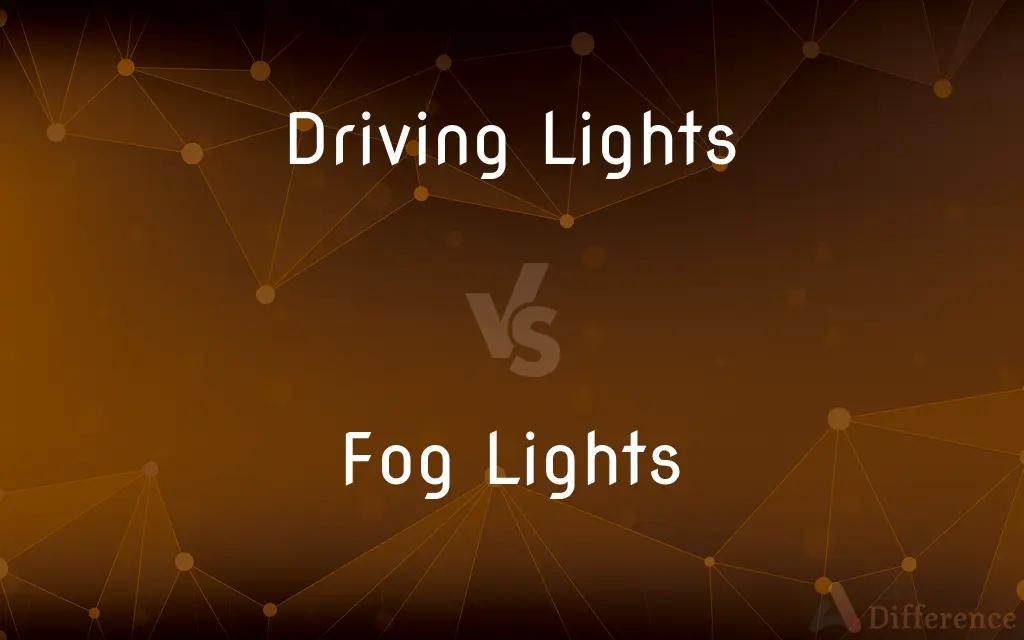Driving Lights vs. Fog Lights — What's the Difference?
By Tayyaba Rehman & Maham Liaqat — Published on March 2, 2024
Driving lights enhance long-range visibility in normal conditions, while fog lights improve short-range vision in poor weather by illuminating the road below fog.

Difference Between Driving Lights and Fog Lights
Table of Contents
ADVERTISEMENT
Key Differences
Driving lights are designed to supplement the high beam of a vehicle's headlights, offering enhanced illumination for long distances. They are particularly useful in rural or poorly lit areas where extra visibility can help identify hazards. Fog lights, on the other hand, have a unique purpose: they are designed to cut through fog, rain, or snow, illuminating the road surface more effectively at a short to medium range without reflecting light back into the driver's eyes.
The beam pattern of driving lights is focused and narrow, aimed to extend the reach of the vehicle's headlights, allowing for better visibility of distant objects. Fog lights produce a wide, low, and flat beam that reduces glare by illuminating the road just in front of the vehicle, helping to highlight the edges of the road and any immediate obstacles.
Driving lights are typically mounted higher than fog lights to project their beam over greater distances. In contrast, fog lights are mounted lower on the vehicle, often near the bumper, to avoid reflection off the fog and to light the roadway more directly in front of the vehicle.
The usage of these lights is dictated by different driving conditions. Driving lights are used during clear conditions to improve visibility when there are no oncoming vehicles to avoid blinding other drivers. Fog lights should be used in foggy or misty conditions to improve near-road visibility without overwhelming incoming traffic with glare.
Choosing between driving lights and fog lights depends on the specific driving conditions encountered. Driving lights are ideal for clear nights and open roads, while fog lights are indispensable in adverse weather conditions, providing safety and visibility close to the vehicle.
ADVERTISEMENT
Comparison Chart
Purpose
Enhance visibility for long distances
Improve visibility in foggy conditions
Beam Pattern
Long, focused beam
Wide, low, and flat beam
Mounting Location
Typically higher on the vehicle
Lower on the vehicle, near the bumper
Visibility Range
Long distance
Short to medium distance
Ideal Conditions
Rural or poorly lit areas, clear nights
Fog, rain, snow, and mist
Compare with Definitions
Driving Lights
Lights designed to extend visibility further than high beams.
Using driving lights to spot deer on a dark, rural road.
Fog Lights
Improve short-range visibility in adverse conditions.
Using fog lights to navigate safely through a snowy night.
Driving Lights
Mounted higher to project light at a distance.
Driving lights are mounted near the roofline for maximum distance illumination.
Fog Lights
Designed to illuminate the road in poor weather.
Turning on fog lights to see the road clearly in dense fog.
Driving Lights
Focuses on distant objects for safety.
Using driving lights to identify hazards on a road far ahead.
Fog Lights
Produce a wide, flat beam to reduce glare.
Fog lights help in illuminating the road's surface without blinding oncoming traffic.
Driving Lights
Ideal for long-distance night driving.
Engaging driving lights on a deserted highway to improve visibility.
Fog Lights
Mounted low on the vehicle.
Fog lights are positioned near the bumper to cut under the fog.
Driving Lights
Supplement the vehicle's main headlights.
Turning on driving lights to illuminate a dark, winding mountain pass.
Fog Lights
Essential for safe driving in fog, rain, or snow.
Activating fog lights to highlight the edges of a fog-covered road.
Common Curiosities
Why are driving lights mounted higher than fog lights?
Driving lights are mounted higher to project their beam further, enhancing long-distance visibility, while fog lights are mounted lower to reduce glare from fog.
What are fog lights?
Fog lights are specialized vehicle lights that improve road visibility in foggy, rainy, or snowy conditions by producing a wide, flat beam close to the ground.
Is it illegal to use driving lights in the city?
Laws vary by location, but using driving lights in a manner that blinds other drivers can be illegal or discouraged in many places.
Can driving lights and fog lights be used together?
While they can be installed on the same vehicle, their usage depends on conditions; driving lights are for clear conditions, and fog lights for poor weather.
What are driving lights?
Driving lights are additional lights designed to enhance a vehicle's high beam, extending visibility at long distances during clear conditions.
Why might someone add aftermarket driving lights?
Aftermarket driving lights can be added for enhanced visibility on vehicles that frequently travel on dark, rural, or unpaved roads.
How do I know when to use fog lights?
Fog lights should be used in fog, heavy rain, or snow to improve near-road visibility and to help other drivers see your vehicle.
Can fog lights blind other drivers?
Properly adjusted fog lights are designed to minimize glare, making them less likely to blind other drivers compared to misaligned headlights or high beams.
Are fog lights only for foggy conditions?
Primarily, yes, but they are also beneficial in rain, snow, and any condition where visibility of the road surface is significantly reduced.
Should fog lights be turned off when fog clears?
Yes, to avoid unnecessary glare to other drivers and because they serve no benefit in clear conditions.
Are LED driving lights better than halogen?
LED lights offer advantages in brightness, energy efficiency, and longevity over halogen bulbs, making them a popular choice for driving lights.
Do all vehicles come with fog lights?
Not all vehicles have fog lights as standard equipment; they are more common on higher trim levels or as an optional accessory.
Can I use fog lights as daytime running lights?
Some vehicles use fog lights as daytime running lights, but their primary purpose is for low visibility conditions.
What's the difference in light color between driving and fog lights?
Driving lights typically emit a white or slightly blue light, while fog lights often emit a yellow light, thought to penetrate fog better.
Can improper use of driving lights be dangerous?
Improper use, such as in traffic or well-lit areas, can dazzle other drivers, leading to unsafe driving conditions.
Share Your Discovery

Previous Comparison
Immediate Annuities vs. Deferred Annuities
Next Comparison
Sociopathy vs. BorderlineAuthor Spotlight
Written by
Tayyaba RehmanTayyaba Rehman is a distinguished writer, currently serving as a primary contributor to askdifference.com. As a researcher in semantics and etymology, Tayyaba's passion for the complexity of languages and their distinctions has found a perfect home on the platform. Tayyaba delves into the intricacies of language, distinguishing between commonly confused words and phrases, thereby providing clarity for readers worldwide.
Co-written by
Maham Liaqat















































